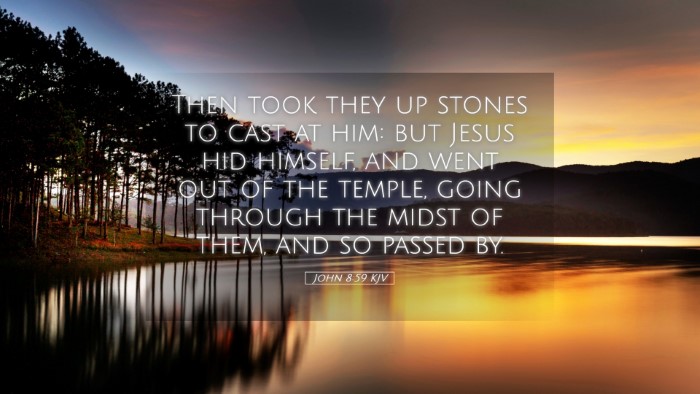Commentary on John 8:59
John 8:59 states, "So they picked up stones to throw at him; but Jesus hid himself and went out of the temple." This verse serves as a pivotal moment in the narrative of John’s Gospel, highlighting the increasing tension between Jesus and the religious authorities. Below, we provide a synthesis of insights from various public domain commentaries to explore the theological and historical significance of this verse.
Historical Context
Albert Barnes notes that this event occurs during the Feast of Tabernacles when Jesus is teaching in the temple. The hostility towards Jesus had crescendoed as He made audacious claims regarding His identity, challenging the established religious practices and interpretations. The act of picking up stones signifies the severity of the offense taken by the Jewish leaders, who deem Jesus guilty of blasphemy, a charge serious enough to warrant death according to their law (Leviticus 24:16).
Significance of "Hiding" Himself
Matthew Henry emphasizes the miraculous nature of Jesus hiding Himself. He suggests that this act not only demonstrates Jesus' divine authority but also serves as a reminder of His mission on earth. Jesus had not yet completed His work — a reality that protects Him from premature death. This theme of protection recurs in John’s Gospel, illustrating that no one could lay a hand on Him until His appointed time (John 7:30).
Symbolism of the Temple
Adam Clarke provides a rich perspective on the symbolism of the temple setting in this verse. The temple represents the place of God's presence and the center of Jewish worship. Jesus's departure from the temple signifies more than just a physical act; it embodies a theological shift. By withdrawing from the temple, Jesus indicates that God's presence departs from the temple systems of the old covenant that are becoming obsolete with the coming of the new covenant (Matthew 12:6).
Confrontation and Rejection
This passage is not merely about Jesus evading a violent confrontation; it is emblematic of a deeper spiritual reality. Barnes highlights that the rejection of Jesus by the religious leaders encapsulates a broader rejection of God’s revelation. They were both blind to the truth and hardened in their hearts. This sets a pattern for understanding how the gospel message would be received by differing groups throughout the New Testament era.
Theological Reflections
The attempt to stone Jesus invites theological reflection regarding judgment and mercy. As Henry articulates, while the leaders were ready to execute justice as they understood it, Jesus exemplified mercy and grace even amidst hostility. This dynamic foreshadows the reality of the Gospel: that Christ’s purpose is to save rather than to condemn, represented poignantly in John 3:17.
Application for Today
- Perseverance in Truth: Believers are called to stand firm in the truth of Jesus' identity, much like Jesus did, regardless of opposition.
- Grace under Fire: Christians should strive to embody Christ's grace in the face of hostility, offering forgiveness and understanding where judgment is often the immediate reaction.
- The Importance of God’s Presence: Just as Jesus departed from the temple that day, believers must discern spaces that no longer reflect God's glory, seeking to dwell in His presence instead.
Conclusion
John 8:59 serves as a crucial verse that encapsulates the growing conflict between Jesus and the religious authorities of His day. The combined insights from Matthew Henry, Albert Barnes, and Adam Clarke provide depth to this narrative, illustrating the significance of Jesus’ ministry, the symbolism of the temple, and the implications of rejection and ongoing grace. For pastors, students, theologians, and scholars alike, this verse challenges each to engage deeply with the nature of Christ in our worship, witness, and daily living.


